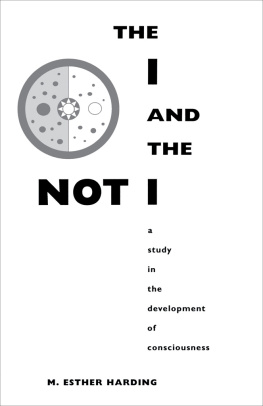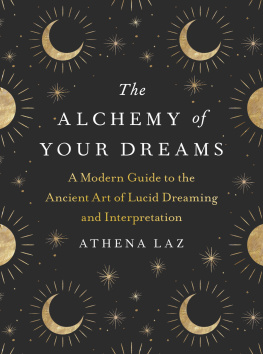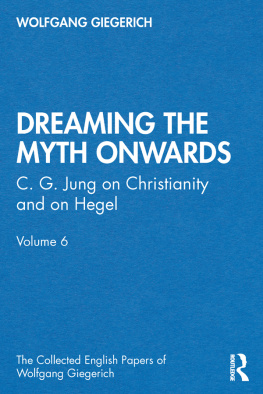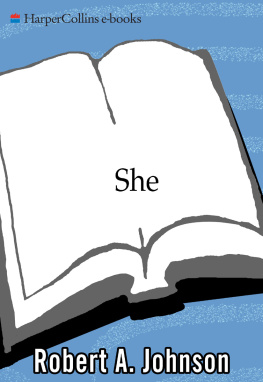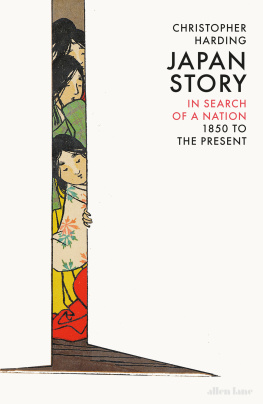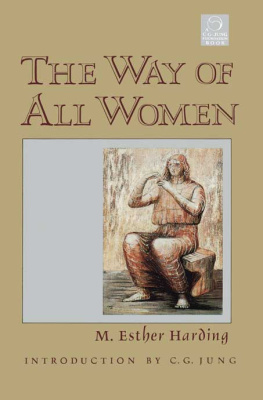This investigation is valuable and important, not only for the specialist, but also for the educated layman, who is interested in a psychology founded on experience of life and the understanding of people.
C. G. Jung
ABOUT THE BOOK
Here is a classic study of the feminine principle in myths, dreams, and religious symbolism. In presenting the archetypal foundations of feminine psychology, the author shows how the ancient religious initiations of the moon goddess symbolized the development of the emotions. Understanding the psychological meaning of these initiations, she believes, can help to heal the troubled relations between men and women today.
M. ESTHER HARDING, M.D., was a leading Jungian analyst for many years and a founder of the Analytical Psychology Club of New York. She is also the author of Womens Mysteries: Ancient and Modern; Psychic Energy: Its Sources and Its Transformation; and I & the Not-I: A Study of the Development of Consciousness.
Sign up to receive news and special offers from Shambhala Publications.

Or visit us online to sign up at shambhala.com/eshambhala.

A C.G. JUNG FOUNDATION BOOK
The C. G. Jung Foundation for Analytical Psychology is dedicated to helping men and women grow in conscious awareness of the psychological realities in themselves and society, find healing and meaning in their lives and greater depth in their relationships, and live in response to their discovered sense of purpose. It welcomes the public to attend its lectures, seminars, films, symposia, and workshops and offers a wide selection of books for sale through its bookstore. The Foundation also publishes Quadrant, a semiannual journal, and books on Analytical Psychology and related subjects. For information about Foundation programs or membership, please write to the C. G. Jung Foundation, 28 East 39th Street, New York, NY 10016.
WOMANS MYSTERIES
Ancient and Modern
M. E STHER H ARDING
Foreword by C. G. Jung

SHAMBHALA
Boulder
2016
S HAMBHALA P UBLICATIONS , I NC .
4720 Walnut Street
Boulder, Colorado 80301
www.shambhala.com
1971 by the C. G. Jung Foundation for Analytical Psychology
All rights reserved. No part of this book may be reproduced in any form or by any means, electronic or mechanical, including photocopying, recording, or by any information storage and retrieval system, without permission in writing from the publisher.
LIBRARY OF CONGRESS CATALOGING-IN-PUBLICATION DATA
Harding, M. Esther (Mary Esther), 18881971.
Womans mysteries: ancient and modern / M. Esther Harding.
p. cm.
Previously published: New York: Published by Putnam for the C.G. Jung Foundation for Analytical Psychology, 1972, cl971.
A C.G. Jung Foundation book.
eISBN 978-0-8348-3045-5
ISBN 1-57062-629-4 (alk. paper)
1. MoonFolklore. 2. MoonMythology. 3. WomenMythology. 4. Sex (Psychology). I. Title.
GR625.H3 199089-29266
398.353dc20 CIP
BVG 01
CONTENTS
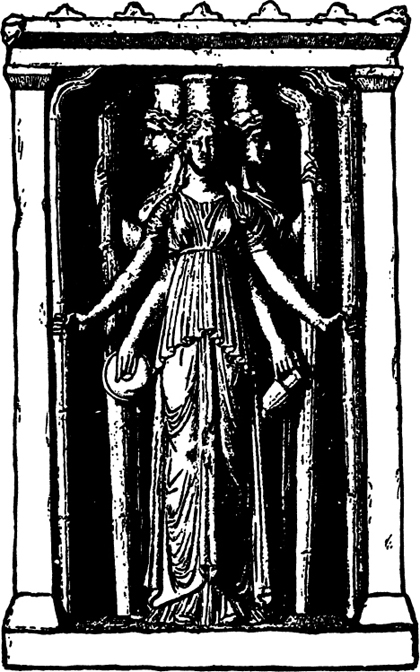
The Hecaterion of Marienbad.
Figure
by
Professor C. G. Jung
Esther Harding, the author of this book, is a physician and specialist in the treatment of psychogenic illness. She is a former pupil of mine and her endeavors have been concerned not only with the understanding of the modern psyche, but in addition, she has tried, as the present book shows, to explore its historical background. Preoccupation with historical subjects may at first glance seem to be merely a physicians personal hobby, but to the psychotherapist it is, in a certain sense, a necessary part of his mental equipment. Concern with the psychology of primitives, with folklore, mythology, and the comparative history of religions opens the eyes to the wide horizons of the human psyche and in addition it gives that indispensable aid we so urgently need for the understanding of unconscious processes. Only when we see in what shape and what guise dream symbols, which are apparently unique, appear on the historical and ethnic scene, can we really understand what they are pointing at. Also, once being equipped with this extensive comparative material, we can succeed in comprehending more nearly that factor which is so decisive for psychic life, namely the archetype. Of course this term is not meant to denote an inherited idea, but rather an inherited mode of psychic functioning, corresponding to that inborn way according to which the chick emerges from the egg; the bird builds its nest; a certain kind of wasp stings the motor ganglion of the caterpillar; and eels find their way to the Bermudas. In other words, it is a pattern of behavior. This aspect of the archetype is the biological oneit is the concern of scientific psychology. But the picture changes at once when looked at from the inside, that is from within the realm of the subjective psyche. Here the archetype presents itself as numinous, that is, it appears as an experience of fundamental importance. Whenever it clothes itself with adequate symbols, which is not always the case, it takes hold of the individual in a startling way, creating a condition of being deeply moved the consequences of which may be immeasurable. It is for this reason that the archetype is so important for the psychology of religion. All religions and all metaphysical concepts rest upon archetypal foundations and, to the extent that we are able to explore them, we succeed in gaining at least a superficial glance behind the scenes of world history, and can lift a little the veil of mystery which hides the meaning of metaphysical ideas. For metaphysics is, as it were, a physics or physiology of the archetype, and its dogma (or teaching) formulates the knowledge of the essence of the dominants, that is, of the unconscious leitmotives, of the psychic happenings predominating in that epoch. The archetype is metaphysical because it transcends consciousness.
Now, Dr. Hardings book represents an attempt to present certain archetypal foundations of feminine psychology. However, in order to understand the authors endeavor, one has to overcome the prejudice that psychology consists merely of what Mr. Smith and Mrs. Jones happen to know about it. The psyche consists not only of the contents of consciousness, which can be said to derive from sensory impressions, but also of ideas which seem to rest upon peculiarly altered sense perceptionssense perceptions which are modified by a priori and unconscious pre-existing formative elements, i.e. by the archetypes. This insight leads us to the conclusion that one part of the psyche may be explained through recent causes, but that another part reaches back to the deepest layers of racial history.
If anything is certain concerning the nature of the neuroses, it is the fact that they are either based upon a primary disturbance of the instincts or at least affect the instincts to a considerable extent. The history of the evolution of human anatomy and of human instincts reaches back into geologic epochs. Our historical knowledge throws light upon but a few paces of this road, whose length may be counted in terms of hundreds of thousands of miles. However, even that little bit is of help when, as psychotherapists, we have to correct a state of disturbance of the instincts. In this connection it is the religions having myths of healing that teach us the most. They might indeed be considered as psychotherapeutic systems which support our understanding of instinctual disturbances, for these are evidently not just of recent date but have existed since the most ancient beginnings of time. Although certain types of illness, notably those of infectious character, as for instance
Next page

